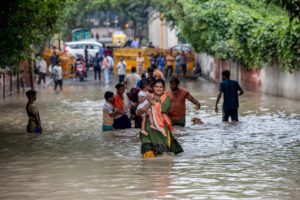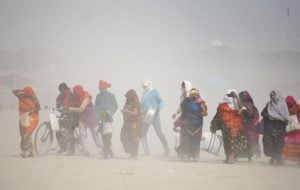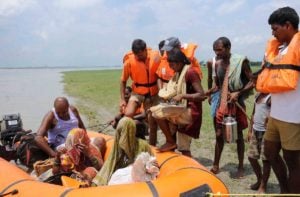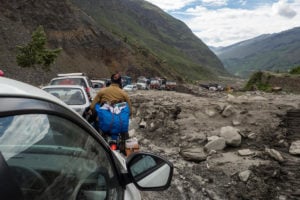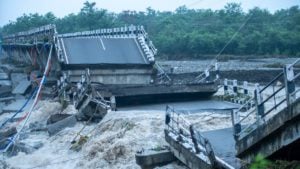Floods in Delhi have dominated the news cycle in India for the last week, setting off political conflicts, and an intense war of words in television studios. And yet, what is lost in the high-decibel rhetoric is a clear understanding of what is happening, and why. More importantly, the key governance lessons for what can be done in both the short-term and the long-term to address challenges are being drowned out by politics.
An excessive focus on Delhi
There are a variety of reasons that the current floods in Delhi have received disproportionate attention. Part of the reason is that New Delhi is the capital city of India, with Delhi being the state in which it is located. Delhi is also governed by the Aam Aadmi Party (AAP) by an elected legislature while other parts of governance – including key portfolios such as policing and land allocation – are in the hands of the Bharatiya Janata Party (BJP), which is in power at the Union government level. Thirdly, the presence of most major media houses in Delhi and television studios in the National Capital Region – which includes Delhi and certain surrounding areas in the states of Uttar Pradesh, Haryana and Rajasthan – means that there is a geographic bias in favour of reporting on issues about Delhi.
This disproportionate focus on Delhi obscures the fact that the current rains are a wider phenomenon, in which the rainfall in Delhi alone plays only a small part. According to the India Meteorological Department (IMD), Delhi received an excess rainfall of 66% in the time period of 1-16 July, 2023. But Delhi is a small region – occupying only 1,483 square kilometres. The much larger upstream provinces of Himachal Pradesh, Haryana, and Uttarakhand received an excess rainfall of 156%, 93%, and 63%, respectively, in the same period. In each of these provinces, many districts are much larger than the total area of Delhi, which means that excess rainfall there has a much bigger impact than the cumulative rainfall in Delhi.
Even this province-wise distribution hides significant anomalies. In Himachal Pradesh the district of Una saw a 100% deficit – zero rainfall – while Bilaaspur district saw a 83% deficit. All the other 10 districts saw excess rainfall, with Kullu – more than three times as large as Delhi – having excess rainfall of 630%.
Nor is the impact of rains limited to India’s borders. Parts of the Sutlej basin in Pakistan saw a “moderate flood”, with more than 26,000 people evacuated and more than 1,500 animals rescued. In north Bangladesh, too, the flood situation is acute, with more than 250,000 people “marooned in Lalmonirhat, Kurigram, Nilphamari and Rangpur” districts.
Looking at the current challenge of managing excess rainfall through the lens of provincial boundaries, therefore, is a mistake. The impact of water flow is across man-made borders, and the variations within these borders are also extreme. While the political opportunity to blame other parties – Himachal, Haryana, and Uttarakhand are all governed by parties other than AAP – is obvious, it does not help the population of any of these provinces.
Ignoring the divides within Delhi
The political spat obscures another major issue, which is the governance of water within Delhi. The city last experienced major floods in 2016, but no lessons seem to have been learnt from that experience. In a 2017 report for the Delhi-based think tank, The Energy and Resources Institute, the principal investigator, Sanjay Gupta notes: “With regard to the management of the storm water drainage system within (…) Delhi, there is, conspicuously, no single institution that bears an overall responsibility of the total system.” He then goes on to mention 10 individual agencies and actors, which include departments overseen by the Union government and some by the state government, as well as autonomous bodies such as the National Green Tribunal and civil society groups, who all bear some part of the responsibility.
In the political squabble, who is exactly accountable for managing the drainage system is totally lost to the public
The BJP has governed at the Union level and the municipal level before the 2016 floods, and AAP has been in power at the provincial level – sandwiched between both – since 2013. Both the political parties have had more than enough time to take up the issues that the 2016 floods had raised, and yet there is no visible improvement of flood management since the last flood. In fact, just before the current floods, the two had been at loggerheads over who gets to manage the Yamuna’s pollution levels, and now they are at loggerheads over the alleged mismanagement of floods. In the political squabble, who is exactly accountable for managing the drainage system is totally lost to the public.
Delhi’s floods will get worse
There are two other issues that the post-2016 floods report highlighted, both of which should make policymakers sit up and take notice. One is the pattern of rainfall, and the other is the pattern of land use.
Drawing on data from the IMD over the period 1901-2016, Gupta states: “the annual precipitation and number of rainy days are increasing; the actual duration of precipitation has reduced, leading to a sharp rise in rainfall intensity from 13.2 mm/hour in 1986 to 22.9 mm/hour in 2016, the latter leading to the inundation of over 50% of the city in three hours.” This is exactly in line with the recent water, ice, society and ecosystems report from the International Centre for Integrated Mountain Development, which noted that rainfall in the western Himalayan areas is likely to increase considerably over this century.
At the same time, land use patterns in Delhi have seen a striking change, making it far more vulnerable to flooding. A study using satellite data from 1989 to 2011 shows a massive increase in the built-up area of Delhi at the cost of “watersheds, loss of forest cover and change in agricultural land”. These are the areas that would have absorbed excess water, but they have been cemented over and now contribute to the flooding.
Many of these issues are municipal in nature. For example, one solution to deal with urban flooding is the water recharge wells in Pakistan’s capital, Islamabad. It has been led by the Capital Development Authority (Islamabad), a municipal authority. In the brouhaha over the mismanagement of floods, it is striking that the roles and responsibilities of municipal authorities are being totally ignored.
Poor always worst impacted
There is also, always, the issue of inequitable distribution of power. The more than 20,000 people evacuated from around the Yamuna basin in Delhi are primarily from poorer communities. Years ago, while discussing allocation of urban resources in the south Indian city of Bengaluru, I was told by researchers at the Janagraaha think tank that city wards with poorer residents and poorer amenities received less attention and money. This was because people living in richer parts of the city had greater influence when demanding resources.
As the flood waters recede, these people will go back to their homes, but will civic amenities improve? Will drainage systems be dealt with, or will these people and areas simply become prey for the next disaster to hit the city?
Authorities across the board have learnt nothing from the last flood that hit Delhi in 2016. All the science indicates that such events are likely to happen with greater frequency, and with greater impact as the world warms. If there is one overwhelming lesson from the floods it is this: The water cycle is changing, and governance systems have to urgently adapt. Clear lines of responsibility must be drawn. Or, policymakers can continue to do what they are doing: shout at each other, while the poor drown.
